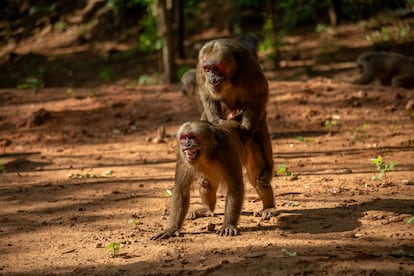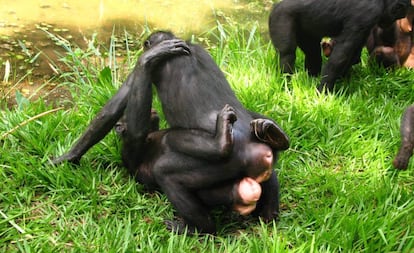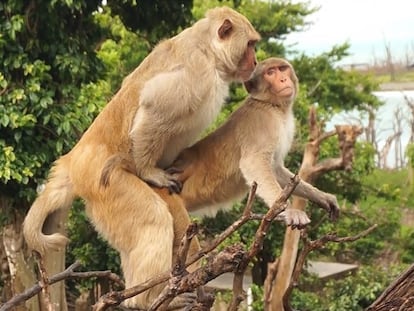Homosexuality in mammals has evolutionary utility, new study finds
Research shows that it is more common in social species where there is lethal aggression between males and functions as an adaptive mechanism to reduce intrasexual violence

Science has documented homosexual behavior in some 1,500 species of all orders of the animal kingdom, from insects to primates, spiders, dolphins, and nematodes. This universality would have puzzled Charles Darwin. In fact, sexual relations with conspecifics of the same sex is considered a Darwinian paradox: from the point of view of the theory of evolution, it entails a cost in the biological efficiency of the individual as it has no direct effect on the ultimate goal, the perpetuation of the species. But there may be other indirect effects that not only explain its survival, but also give it a prominent role in the evolution of a large part of living beings. This is what is suggested by a study that shows how homosexual behavior in mammals, although a minority, is more frequent in the most social species.
Some of the theories about the reasons for same-sex intercourse among animals are reminiscent of those held until not long ago to explain human homosexuality. Two schools of thought maintain that it is a case of identity confusion, or caused by the frustration of not being able to mate with the opposite sex. A third theory is based on what is observed when life is caged: the reduced availability of the opposite sex and the control exercised over animals living in captivity in institutions such as zoos or laboratories leads to homosexual practices. However, some argue that homosexuality may be an adaptive advantage.
Research conducted by Spanish scientists and published in the journal Nature Communications has reviewed what science knows about homosexuality among mammals. The results show that of the more than 4,300 species of the class Mammalia, homosexual behavior has been documented in 261 (4%). The range of these behaviors is very broad: from copulation to having a stable partner of the same sex, including genital contact or simple courtship. The percentage rises as one moves up the taxonomy (the way biologists organize the tree of life). Thus, above the species, homosexual relationships exist in half of the mammalian families, a figure that rises to 63% at the next level, that of the order. They have also found that there are no major gender differences: males have sex with males in 199 species, while females have sex with females in 163 species. In more than half of the species, specimens of both genders display some homosexual behavior.
Within this tree of life, homosexual behavior tends to be more frequent in some branches than in others. The orders where it is most common are carnivores, ungulates, marsupials — such as kangaroos and wallabies — rodents and, above all, primates. This last order alone includes 51 species where homosexuality is relatively common.
The work goes beyond quantifying homosexual behavior and attempts to determine if it contributes something to evolutionary progress. To do so, the researchers applied the phylogenetic approach which, in the words of University of Valencia researcher and co-author of the study, Miguel Verdú, “uses the trace left by evolution in all species to study how and when a certain behavior has originated.” In their analysis, the scientists found that homosexuality has arisen independently in different lineages. “By mapping sexual behavior between individuals of the same sex across species in the mammalian phylogeny, we have been able to ascertain how many times it has evolved, whether it has evolved recently or not, and whether it is associated with other behaviors that can also be mapped in the phylogeny,” Verdú adds.

What the researchers found is that homosexual behavior does not appear randomly distributed among the different species. This implies, says José María Gómez of the Experimental Station of Arid Zones (EEZA) and lead author of the study, “that this behavior appears concentrated in groups of evolutionarily related species, for example, in several species of rodents or in various species of ungulates, or in many primates.”
With this non-random distribution and the phylogenetic approach, the researchers were able to test two hypotheses about the survival of animal homosexuality. On the one hand, they wanted to see if these behaviors had a social function. On the other, they investigated their relationship with aggression between adults, or adulticide. Their results suggest that this is not a Darwinian paradox. The study detected a significant association between the occurrence of sexual behavior between individuals of the same sex and the establishment and maintenance of social bonds. As such, the more social the species, the more likely it is to exhibit these types of interactions.
This is extremely interesting, as it suggests that homosexual behavior in males could have evolved as a way to mitigate intrasexual aggression, but only between males”Antonio J. Osuna, expert in animal cognition at the University of Veterinary Medicine Vienna
“Our study suggests that sexual behavior between individuals of the same sex exhibited by non-human mammals, rather than aberrant or maladaptive behavior, is an adaptation that plays an important role in the maintenance of social relationships in both sexes,” Gómez says. In some cases, such as with rhesus macaques in Puerto Rico, males have more sex with other males than with females, and do so to reinforce their coalitions.
The researchers also confirmed, albeit partially, their other hypothesis by observing a correlation between adulticide and homosexuality in species where aggression within the same sex is common, as in those with hierarchical groups such as baboons and mandrills. But this connection only occurs in the case of males. Regarding this difference, University of Granada researcher and co-author of the study, Adela González, explains: “We think that this occurs because the main factor that correlates with sexual behavior between individuals of the same sex in females is the development of social bonds rather than the avoidance of intrasexual conflicts.” The archetypal example of the former would be bonobos, which rub their genitals as a means of reinforcing their bonds.
The evolution of homosexual behavior in males and its relationship with the previous existence of adulticide is one of the results of the study that Antonio J. Osuna, an expert in animal cognition at the University of Veterinary Medicine Vienna, highlights the most: “This is extremely interesting, as it suggests that homosexual behavior in males could have evolved as a way to mitigate intrasexual aggression, but only between males,” he told the Spanish Science Media Centre. For Osuna, who did not participate in this study, other types of non-lethal violence should be investigated in more depth to see if sex between females does play a role. “The study of homosexual behavior has been very limited both in humans and in other animal species for reasons that we are all aware of, and these reasons are purely social. It is very interesting to discover that our common ancestors and other great apes, with great probability, displayed these behaviors, and that they are as natural as any other.”
Sign up for our weekly newsletter to get more English-language news coverage from EL PAÍS USA Edition
Tu suscripción se está usando en otro dispositivo
¿Quieres añadir otro usuario a tu suscripción?
Si continúas leyendo en este dispositivo, no se podrá leer en el otro.
FlechaTu suscripción se está usando en otro dispositivo y solo puedes acceder a EL PAÍS desde un dispositivo a la vez.
Si quieres compartir tu cuenta, cambia tu suscripción a la modalidad Premium, así podrás añadir otro usuario. Cada uno accederá con su propia cuenta de email, lo que os permitirá personalizar vuestra experiencia en EL PAÍS.
¿Tienes una suscripción de empresa? Accede aquí para contratar más cuentas.
En el caso de no saber quién está usando tu cuenta, te recomendamos cambiar tu contraseña aquí.
Si decides continuar compartiendo tu cuenta, este mensaje se mostrará en tu dispositivo y en el de la otra persona que está usando tu cuenta de forma indefinida, afectando a tu experiencia de lectura. Puedes consultar aquí los términos y condiciones de la suscripción digital.











































